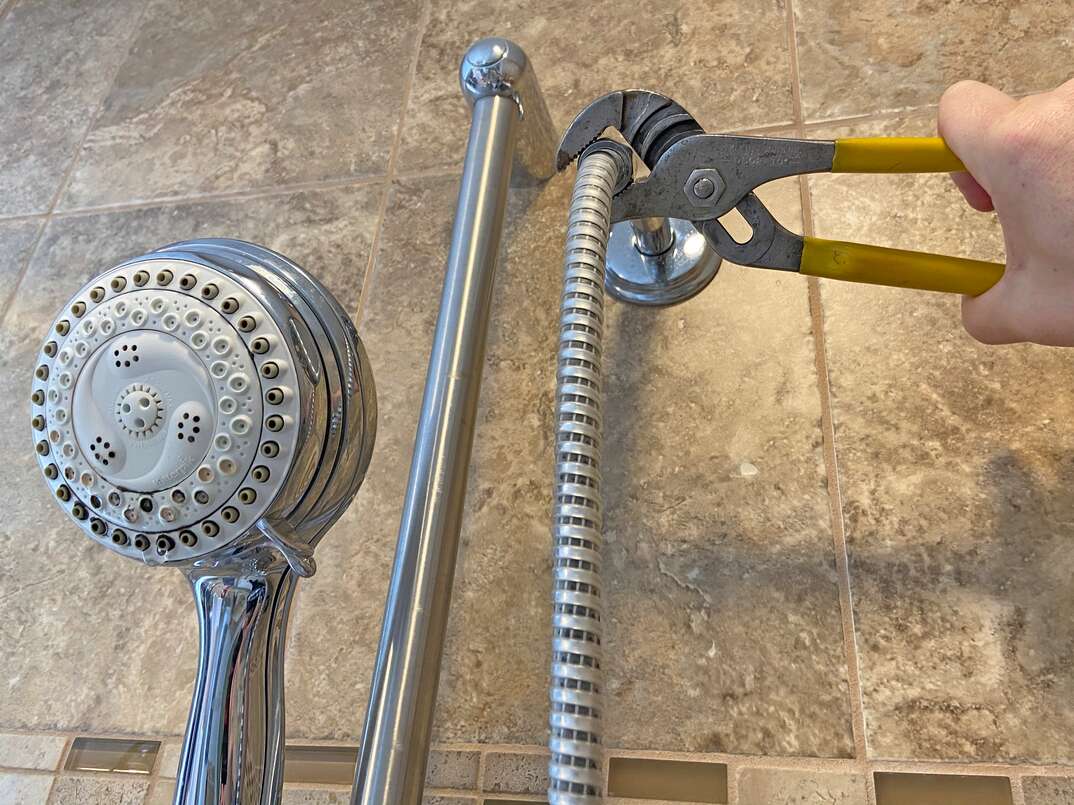Is your showerhead stubbornly stuck, refusing to budge no matter how much you twist or turn? You’re not alone.
Many people face this common household challenge, and it can be frustrating, especially when you’re looking forward to a refreshing shower. But don’t worry! Removing a stuck showerhead doesn’t have to be a daunting task. In fact, with the right techniques, you can have it off in no time, ready for a new one or just a good cleaning.
Imagine the satisfaction of tackling this issue yourself, saving money on potential plumbing costs, and gaining a little DIY confidence along the way. Ready to discover the secrets to freeing your showerhead without damaging your bathroom fixtures? Keep reading, and you’ll be a showerhead removal pro in no time!
Tools And Materials Needed
Removing a stuck showerhead can be frustrating. But with the right tools, it’s manageable. Having the correct materials ensures a smooth process. This guide will list essential tools and materials needed. Let’s dive in and tackle that stubborn showerhead.
Tools Needed
First, you’ll need a wrench. An adjustable wrench works best for this task. It lets you tighten or loosen the grip easily. Next, grab some pliers. They help with grip and twist. Channel-lock pliers are highly recommended for their versatility.
A screwdriver might come in handy. Use it to remove any screws on the showerhead. Keep a small brush nearby. A toothbrush works well for cleaning grime. It helps ensure a clean and smooth removal.
Materials Needed
Gather a few essential materials. First, you’ll need plumber’s tape. It ensures a watertight seal during reinstallation. Have a cloth or rag ready. Use it to protect the showerhead’s finish from scratches.
A bucket or basin is useful too. It catches any falling water or debris. Finally, keep a lubricant nearby. WD-40 or a similar product helps loosen stuck parts.
Safety Equipment
Don’t overlook safety. Wear protective gloves. They protect your hands from sharp edges. Safety goggles are a good idea too. They shield your eyes from debris or water splashes.
Ensure you have a stable ladder if needed. It helps reach higher showerheads safely. Always be cautious and aware of your surroundings.
Safety Precautions
Removing a stuck showerhead can be tricky. Safety is important during this task. Taking the right precautions ensures a smooth and accident-free process. Follow these safety tips to protect yourself and your bathroom.
Wear Protective Gear
Always wear gloves to protect your hands. They prevent cuts or bruises. Safety glasses shield your eyes from debris. They are essential when using tools.
Turn Off The Water Supply
Before starting, shut off the water. This prevents accidental leaks or sprays. Locate the main valve and turn it off. Check for any remaining water in the pipes.
Use The Right Tools
Use tools that fit well with your showerhead. A wrench or pliers may be necessary. Ensure the tools are in good condition. Avoid using damaged or rusty tools.
Be Mindful Of Slippery Surfaces
Bathrooms can be slippery when wet. Ensure the floor is dry before you start. Wear shoes with good grip to prevent slipping. Consider placing a mat for extra safety.
Work In A Well-lit Area
A well-lit bathroom is crucial for safety. Ensure the lighting is bright and clear. Use a flashlight if needed to see small parts. Proper lighting helps avoid mistakes.
Handle Chemicals Carefully
Some may use chemicals to loosen the showerhead. Always read labels on products. Wear protective gear when handling chemicals. Ensure the bathroom is well-ventilated.
Assessing The Situation
Start by examining the showerhead for visible rust or mineral deposits. Check the connection points for any signs of corrosion. Identifying these issues helps determine the right tools and methods needed for safe removal.
Removing a stuck showerhead can be a challenging task, but it starts with assessing the situation. Understanding why the showerhead is stuck and evaluating the tools you have on hand is crucial. This first step sets the foundation for a successful removal, ensuring you approach the task with clarity and efficiency.Check For Rust And Corrosion
Rust and corrosion are common culprits behind a stuck showerhead. These elements can bind the showerhead to the pipe, making it difficult to unscrew. Look closely at the connection point for signs of discoloration or flaky residue. If you spot these signs, it might be time to consider using a rust remover or lubricant to help loosen the bond.Inspect For Mineral Deposits
Mineral deposits from hard water can accumulate over time, cementing the showerhead in place. Carefully examine the area where the showerhead meets the pipe. White or green crusty buildup suggests mineral deposits. In this case, soaking the connection with vinegar can be a simple yet effective solution to dissolve the deposits and ease the removal process.Evaluate Your Tools
Before jumping into action, take stock of the tools at your disposal. A wrench or pliers might be necessary to grip and twist the showerhead. However, be cautious of using excessive force, as this can damage the plumbing. Ensure you have a cloth or rubber grip to protect the finish of the showerhead while using tools. Sometimes, improvising with household items like rubber bands can provide the grip needed without causing harm.Consider The Showerhead Type
Not all showerheads are created equal. Some models have unique designs or locking mechanisms that make removal tricky. Identify the type of showerhead you’re dealing with. Is it a fixed model, or does it have a swivel joint? This knowledge can direct your approach, perhaps nudging you to look up a specific tutorial or manual for guidance.Reflect On Previous Attempts
Think back on any previous attempts to remove the showerhead. Did you use any forceful techniques that might have worsened the situation? Understanding what’s been tried before can prevent repetitive mistakes and guide you toward more effective strategies. Sometimes, a fresh approach can make all the difference. Once you’ve assessed the situation, you’ll be better prepared to tackle the task at hand. What challenges have you faced with home repairs, and how did you overcome them? Engaging with these questions can lead to a more informed and confident approach when removing a stuck showerhead.Applying Lubricants
Removing a stuck showerhead can be frustrating. Applying lubricants offers an effective solution. Lubricants can loosen the showerhead, making removal easier. This process is simple and requires minimal tools. Let’s explore the types of lubricants and the best techniques for application.
Types Of Lubricants
Different lubricants work for different situations. Penetrating oils, like WD-40, are popular choices. They can seep into tiny spaces, breaking rust and mineral deposits. Silicone spray is another option. It’s great for metal parts and leaves a protective layer. Another choice is petroleum jelly. It’s thicker but effective for metal threads. Choose the right lubricant for your showerhead.
Application Techniques
Applying lubricants correctly ensures success. First, ensure the area is dry. This prevents dilution of the lubricant. Spray or apply a small amount to the base of the showerhead. Allow it to sit for 5-10 minutes. This gives time for the lubricant to penetrate. Use a cloth to wipe away excess. If needed, reapply and wait longer. This ensures the lubricant reaches all areas. Repeat these steps for stubborn cases.
Using Heat Methods
Removing a stuck showerhead can be a frustrating experience. Fortunately, using heat methods can make the task easier. Heat can help loosen the connections, making removal less challenging. But how can you use heat safely and effectively? Let’s delve into this approach.
Safe Heat Sources
Use a hairdryer or a heat gun for this task. These tools are common and easy to control. Avoid open flames which can damage bathroom fixtures. Hairdryers are safer for home use. Heat guns are more powerful, but require caution.
Heat Application Tips
Start by heating the showerhead gently. Keep the heat source moving to avoid overheating. Focus on the metal parts, not plastic. Apply heat for a minute or two. Test the showerhead’s looseness after heating. Repeat if necessary, but don’t overheat.

Credit: www.homeserve.com
Leveraging Force
Removing a stuck showerhead can be challenging. Sometimes, you need to apply force. Leveraging force is effective but requires caution. Applying too much force can damage the showerhead or pipes. Using the right tools and techniques is crucial.
Proper Tools For Force
Using the right tools makes the task easier. A wrench is essential for gripping the showerhead firmly. Ensure the wrench is adjustable for a snug fit. A pair of pliers can also help. They provide extra grip and control. Rubber gloves improve grip and protect your hands. These tools minimize the risk of slipping. They ensure you apply force evenly.
Avoiding Damage
Preventing damage is crucial when applying force. Wrap the showerhead in a cloth to protect its surface. The cloth acts as a cushion against scratches. Avoid using excessive force. Gentle pressure is often enough to loosen it. Check the pipes for signs of wear. Damaged pipes can break under pressure. If unsure, consult a professional. Using force correctly is key to a successful removal.
Dealing With Corrosion
Removing a stuck showerhead often involves addressing corrosion. Use penetrating oil to loosen rusted threads. Gently twist with a wrench, applying gradual pressure to avoid damage.
Dealing with a stuck showerhead can be a frustrating experience, especially when corrosion is involved. Corrosion often acts like a stubborn barrier, making your showerhead seem immovable. But before you decide to call in a plumber, understanding how to identify and tackle corrosion can save you both time and money. By addressing corrosion head-on, you can restore your showerhead’s functionality and ensure a smooth, water-flowing shower experience.Identifying Corrosion
Corrosion is often the culprit behind a stuck showerhead. It typically appears as a greenish or white crust around the joints and threads. This crusty build-up not only makes the showerhead hard to remove but also affects water flow over time. To spot corrosion, examine the base of your showerhead closely. If you notice any discoloration or build-up, you’re likely dealing with corrosion. Remember, early detection can make the removal process much easier.Corrosion Removal Techniques
Once you’ve identified corrosion, it’s time to take action. Start by gathering simple household items like white vinegar and baking soda. These can be surprisingly effective in breaking down corrosion. Step 1: Fill a plastic bag with white vinegar and secure it around the showerhead with a rubber band. Let it soak for a few hours. Vinegar’s acidic nature helps dissolve the mineral deposits. Step 2: Remove the bag and scrub the area with a toothbrush dipped in baking soda. This helps in removing any remaining residue. Step 3: If the showerhead is still stuck, try using a wrench. But be gentle to avoid damaging the fixture. A bit of patience can go a long way here. Have you ever tried removing a stubborn showerhead only to give up in frustration? Share your experience in the comments. Your insights could be the missing piece for someone else tackling the same issue. By addressing corrosion effectively, you ensure a smooth removal process and a more enjoyable shower experience.
Credit: diy.stackexchange.com
Cleaning And Maintenance
Loosen a stuck showerhead easily by using a wrench wrapped in a cloth to avoid scratches. Apply penetrating oil and let it sit for a few minutes. Twist gently until it detaches. Regular cleaning prevents future issues.
Cleaning and maintenance are key to ensuring your showerhead works efficiently and lasts longer. A stuck showerhead can be a real annoyance, but with a bit of care and attention, you can prevent it from happening. Regular cleaning not only helps avoid such problems but also ensures a steady flow of water, making your showers more enjoyable.Preventative Measures
Preventing a showerhead from getting stuck starts with simple measures. Ensure you regularly check for mineral build-up. Hard water can lead to limescale, causing the showerhead to jam. Consider using a water softener if you live in a hard water area. This reduces mineral deposits and keeps your showerhead functioning smoothly. Another effective strategy is to apply a thin layer of petroleum jelly around the showerhead’s threads. This can help prevent rust and mineral deposits from forming.Regular Maintenance Tips
Regular maintenance is your best defense against a stuck showerhead. Start with cleaning your showerhead once a month. Remove it and soak it in a vinegar solution for a few hours to dissolve any mineral build-up. Use a soft brush to scrub away any remaining residue. A toothbrush works great for this task, reaching into those tiny nozzles where deposits can hide. After cleaning, rinse thoroughly and dry before reattaching. This simple routine can extend the life of your showerhead and keep your water flow steady. Have you ever noticed your shower water pressure dropping? It might be time for a cleaning session. Consistent maintenance not only prevents issues but also enhances your daily shower experience. By implementing these practical tips, you’re not just maintaining your bathroom fixtures—you’re investing in your comfort and saving potential repair costs. What’s your next step to ensure a hassle-free shower experience?
Credit: www.youtube.com
Frequently Asked Questions
How Do You Remove A Stuck Showerhead?
Apply penetrating oil to loosen the threads. Use a wrench to gently turn it counterclockwise.
What Tools Are Needed For This Task?
You’ll need a wrench, penetrating oil, and a cloth. Simple tools for an easy job.
Can Vinegar Help In Loosening A Showerhead?
Yes, soak the showerhead in vinegar. It helps dissolve mineral deposits that cause sticking.
Is It Safe To Use Force On A Stuck Showerhead?
No, using too much force can damage pipes. Apply gentle pressure and use penetrating oil.
How Long Should I Soak The Showerhead In Vinegar?
Soak for about 30 minutes. This time is usually enough to break down deposits.
Conclusion
Removing a stuck showerhead can be simple with the right steps. Start by loosening it with a wrench. Use vinegar to dissolve mineral build-up. If it’s still stuck, try heating the showerhead lightly. This can expand the metal, making it easier to remove.
Remember to handle tools carefully. Once removed, clean the threads before installing a new showerhead. Regular cleaning helps prevent future problems. Enjoy smoother showers with a well-maintained bathroom fixture. Follow these tips and keep your showerhead easy to manage. No more struggles with stuck showerheads.
Happy showering!





